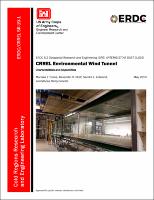Please use this identifier to cite or link to this item:
https://hdl.handle.net/11681/32733Full metadata record
| DC Field | Value | Language |
|---|---|---|
| dc.contributor.author | Torres, Marissa J. | - |
| dc.contributor.author | Stott, Alexander R. | - |
| dc.contributor.author | LeGrand, Sandra L. | - |
| dc.contributor.author | Reilly-Collette, Marina I. | - |
| dc.date.accessioned | 2019-05-22T19:41:30Z | - |
| dc.date.available | 2019-05-22T19:41:30Z | - |
| dc.date.issued | 2019-05 | - |
| dc.identifier.govdoc | ERDC/CRREL SR-19-1 | - |
| dc.identifier.uri | https://hdl.handle.net/11681/32733 | - |
| dc.identifier.uri | http://dx.doi.org/10.21079/11681/32733 | - |
| dc.description | Technical Report | - |
| dc.description.abstract | Atmospheric, or environmental, wind tunnels are ideal for basic research and applied physical modeling and for supporting the numerical model validation process. The U.S. Army Corps of Engineers, Engineer Research and Development Center (ERDC), has had an active presence in the field of research physical modeling. Between the ERDC Environmental Laboratory (EL), the Cold Regions Research and Engineering Laboratory (CRREL), and the Geotechnical and Structures Laboratory (GSL), there is one historical, three operational, and one future planned atmospheric wind tunnel. Each facility was uniquely designed to study different areas of atmospheric phenomena. This report reviews and highlights the characteristics of each facility and their target research applications. In particular, there is a desire to expand the scope of the CRREL Environmental Wind Tunnel (EWT) physical modeling capability. Expanding that capability be-yond snowdrift modeling opens the door to geometrically full-scale turbulent-boundary-layer experiments on air-land and potentially air-water interfaces. Sustaining and improving internal wind-tunnel facilities is vital to the ERDC mission, promoting innovation and versatility in atmospheric physical modeling. | en_US |
| dc.description.sponsorship | United States. Office of the Assistant Secretary of the Army for Acquisition, Logistics, and Technology. | en_US |
| dc.description.tableofcontents | Abstract .......................................................................................................................................................... ii Figures and Tables ........................................................................................................................................ iv Preface ............................................................................................................................................................ vi Acronyms and Abbreviations .....................................................................................................................vii Unit Conversion Factors ........................................................................................................................... viii 1 Introduction ............................................................................................................................................ 1 1.1 Objective .......................................................................................................................... 1 1.2 Background ..................................................................................................................... 2 1.2.1 Modeling the atmospheric boundary layer ........................................................................ 3 1.2.2 Wind-tunnel configurations ................................................................................................. 5 1.2.3 ERDC wind-tunnel facilities ................................................................................................. 7 1.3 Approach ....................................................................................................................... 10 2 CRREL Environmental Wind Tunnel ................................................................................................ 11 2.1 Wind-tunnel structure ................................................................................................... 11 2.1.1 Contraction ........................................................................................................................ 11 2.1.2 Test section ........................................................................................................................ 13 2.1.3 Fan ...................................................................................................................................... 16 2.1.4 Downstream trap ............................................................................................................... 16 2.2 Instrumentation ............................................................................................................ 18 2.2.1 Range-finding sensor ........................................................................................................ 18 2.2.2 Hot-wire anemometer ........................................................................................................ 20 2.2.3 Pitot tube ............................................................................................................................ 21 2.3 Velocity profile ............................................................................................................... 22 3 Recommendations for Expanded Capability ................................................................................. 23 3.1 Modular test section ..................................................................................................... 23 3.2 Exhaust control for hazardous materials ..................................................................... 23 3.3 Particle image velocimetry ........................................................................................... 24 3.4 Cold capabilities............................................................................................................ 25 4 Summary ............................................................................................................................................... 26 References ................................................................................................................................................... 29 Appendix A: Supplemental Information ................................................................................................. 32 Report Documentation Page | - |
| dc.format.extent | 46 pages / 3.946 Mb | - |
| dc.format.medium | PDF/A | - |
| dc.language.iso | en_US | en_US |
| dc.publisher | Cold Regions Research and Engineering Laboratory (U.S.) | en_US |
| dc.publisher | Engineer Research and Development Center (U.S.) | - |
| dc.relation.ispartofseries | Special Report (Engineer Research and Development Center (U.S.)) ; no. ERDC/CRREL SR-19-1 | - |
| dc.rights | Approved for Public Release; Distribution is Unlimited | - |
| dc.source | This Digital Resource was created in Microsoft Word and Adobe Acrobat | - |
| dc.subject | Aerodynamics | en_US |
| dc.subject | Atmospheric physics | en_US |
| dc.subject | Atmospheric sciences | en_US |
| dc.subject | Scientific apparatus and instruments | en_US |
| dc.subject | Wind tunnels | en_US |
| dc.title | CRREL Environmental Wind Tunnel : characteristics and capabilities | en_US |
| dc.type | Report | en_US |
| Appears in Collections: | Special Report | |
Files in This Item:
| File | Description | Size | Format | |
|---|---|---|---|---|
| ERDC-CRREL SR-19-1.pdf | 4.04 MB | Adobe PDF |  View/Open |